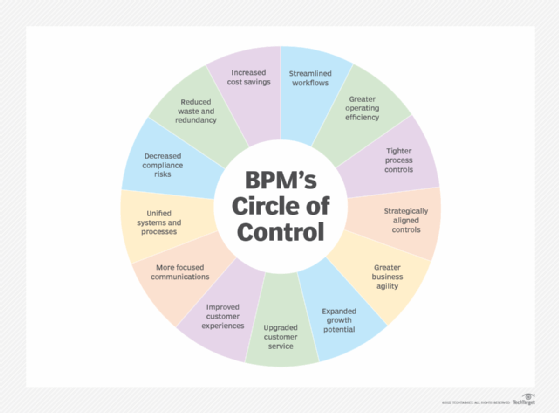7 top business process management benefits, advantages
Streamlined workflows, greater agility and scalability, tighter process controls, reduced risks, lower costs and better customer engagements are among the notable BPM benefits.
Enterprises rely on business process management to better understand how they operate, remain competitive and gain an edge in the marketplace. BPM initiatives typically require considerable investments in technology deployments and cultural changes. But the payoff likewise can be considerable.
High on the list of BPM benefits is its capacity to improve automation and understand complex processes. Business process automation technologies can accelerate digital transformation initiatives and speed the release of new services.
Mapping business processes, a key element of BPM, helps process experts identify opportunities to lower costs, eliminate waste, smooth operations, connect the dots between processes, increase business agility and upgrade customer service. It can also improve process controls and facilitate the implementation of new programs and technologies.
Additionally, sophisticated process capture tools using machine vision and process mining -- a technique that analyzes event logs to improve business processes -- give companies insight into existing processes and help them automate the rollout of new ones.
Business process management benefits
Business process management is a structured approach to improving the processes organizations use to get work done. It's a broad discipline and, by definition, a dynamic one given how the organizational roles, rules, tactics, business goals and other elements it encompasses are constantly changing.
Here is a detailed analysis of seven benefits organizations reap by practicing BPM.
1. Streamlined workflows and greater efficiency
Improvements in work quality and operating efficiency are the primary reasons for adopting BPM. "BPM allows organizations to streamline workflows by automating tedious manual tasks, such as data management, data flows, data entry, approval processes and report generation," said Isaac Gould, research manager at Nucleus Research.
BPM standardizes processes so employees can work more effectively within a set framework that speeds decision-making and reduces the risk of human error. BPM tools also embed analytics that provide managers a bird's-eye view of how their department and individual processes are performing -- for example, tracking employee performance and identifying bottlenecks in workflows.
The combination of automated workflows, standardized processes and process monitoring increases the quality and quantity of worker output. Team members have more time to identify further opportunities for process improvement and automation while managing the BPM tasks that require human intervention, experience and expertise.

2. Tighter, strategically aligned process controls
Business processes tend to grow organically and haphazardly when left to the whims of different managers. As each process takes shape, business managers and project management teams must address new requirements spanning tax jurisdiction, regulatory mandates, contractual obligations and security. In addition, they need to shoehorn these requirements into the data formats and fields that are woven into ERP, CRM and human capital management systems.
BPM takes a more systematic approach to understanding the origins of each process and how it can be streamlined to support the same requirements but with fewer steps, less data and less manual effort. "With more clearly defined and precise processes in place across the board, businesses are given tighter control over all value-added internal and external activities," explained Monty Staggs, director of IT application operations at Boyd Gaming. This visibility creates an opportunity to implement technologies and ensures all business models are strategically aligned to the marketplace.
3. Greater business agility and scalability
Increased understanding and control of processes provide greater flexibility when pivoting to new opportunities, Staggs noted. Quick and nimble organizations are increasingly gaining an advantage over slower-moving legacy businesses. BPM creates an architectural avenue to new cloud services, AI capabilities, regulatory changes and market opportunities.
"The companies that can deliver value-added service through the most flexible and expedited methods," Staggs reasoned, "are the ones that will excel and grow -- the ones that don't [will] stagnate or will eventually die off."

4. Better customer service and experiences
Business process management benefits customer experiences in several ways, said Dana Daher, associate practice leader at HFS Research, an IT advisory group. BPM can help businesses do the following:
- Analyze existing processes to identify areas where customer service reps waste time entering redundant information into a system.
- Automatically collect and sort required customer information from multiple sources and eliminate redundancy.
- Discover better ways to help customers see how far along they are in a complex process and what additional steps are required.
- Improve the development, manufacture and quality of the final product delivered to customers.
5. Connected silos and more focused communications
Business process management software can help connect siloed systems and processes by simplifying the technical work and improving communication. BPM's real-time visualization capabilities connect people, processes, information systems, software, SaaS platforms and machines, observed Valentina Botnari, a freelance SAP technical function consultant. BPM can transform graphical models into executable commands to automate IT integration of business process automation.
Botnari said BPM software can help manage software releases by monitoring progress and identifying disruptions in the process. When blocking issues are discovered, the BPM software limits communication to the key decision-makers and specifies ways to resolve the bottlenecks. "Narrowing communication to just the key people at that step," Botnari explained, "means not wasting everyone else's time in general coordination meetings or with massive email and other communication chains."
6. Reduced risk, waste, redundancy and money pits
BPM helps business managers and teams assess the current state of their business processes and identify areas to consolidate and optimize them, said Dan Shimmerman, CEO at business process design and management platform provider Blueprint Software Systems. The goal is to eliminate waste, redundancy, error-prone sequences, compliance risks and automation deployments that are losing money.
According to Shimmerman, one of his customers discovered that an automated process was costing $1 million annually to maintain but delivering only $300,000 in business value. Part of the automation was retired in favor of manual execution, saving the company $700,000 a year.
7. Understanding complex processes
Vendors are increasingly developing new tools to automate the process of dissecting and modeling existing business processes. For example, process mining analyzes event logs from ERP, CRM and supply chain management systems to model existing processes and identify areas of variance. Process capture tools, sometime called task mining, use machine vision analysis of a worker's interactions with the user interface to map the steps of specific processes.
These tools help fill in the blanks as to how processes are executed in practice, which can differ from the way employees and managers imagine. This insight can help improve collaboration on process improvement initiatives. Additionally, these tools can automate many aspects of complex processes by helping decompose processes into tasks that might best be completed by humans or by AI and humans working together.
George Lawton is a journalist based in London. Over the last 30 years he has written more than 3,000 stories about computers, communications, knowledge management, business, health and other areas that interest him.





